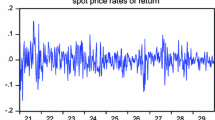Abstract
Estimation of the price-induced welfare effects in vertical and horizontal market settings may prove a tricky task when multiple price changes are taken into account. Whether a multi-market sequential approach or a single-market approach is used the well-established, theoretical result suggests that these two partial equilibrium methods are equivalent in terms of implied welfare changes. This paper develops the methodology to empirically compare these two methods. We estimate the welfare changes to Greek cotton–yarn producers induced by the simultaneous change in the prices of cotton–yarn and the cost of labor. Results substantiate the multi-market approach offers more accurate welfare estimates than the single-market approach, in empirical work.



Similar content being viewed by others
Notes
Greece is considered to be a small exporting country where prices are determined exogenously.
Final prices of cotton–yarn products can be perceived as intervention prices (observed in the domestic markets) and initial prices as the non-intervention prices (observed in the international markets).
For \(\pi = \sum\limits_{i = 1}^m {p_i q_i \left( x \right) - } \sum\limits_{j = 1}^m {w_j x_j - {\text{TFC}}} \) and the FOC \(\frac{{\partial \pi }}{{\partial x_j }} = \sum\limits_{i = 1}^m {p_i \frac{{\partial q_i }}{{\partial x_j }}} - w_j = 0\) the derived demand equals \(x_j = \overline {x_j } \left( {p,w} \right)\) and supply equals \(q_i = \overline {q_i } \left( {p,w} \right)\). Consequently, quasi-rents equal \(R = R\left( {p,w} \right) = \sum\limits_{i = 1}^m {p_i \overline q _i \left( x \right) - } \sum\limits_{j = 1}^m {w_j \overline x _j \left( {p,w} \right)} \) and \(\frac{{\partial R}}{{\partial p_i }} = \overline q _i \left( {p,w} \right)\) (See Just et al. 1982)
Alternatively, we could approach this problem by splitting a shutdown path into three parts \(\left[ {\Delta R = \Delta R\left( {{\text{part}} \,1} \right) + \Delta R\left( {{\text{part}}\,2} \right) + \Delta R\left( {{\text{part}}\,3} \right)} \right]\) where we would initially change the price of cotton yarn from initial prices to shutdown prices (part 1), then the cost of labor (part 2) and, finally, cotton-yarn prices from shutdown to final levels. Next we would take the line integral and eliminate all the zero integrals, i.e., part 2 which is passing through the shutdown zone and the labor integral in parts 1 and 3 which is equal to zero as both the upper and the lower limits of the integral are equal.
There is no price-induced welfare effect on producers of yarn in this market because there is no intervention in this market and domestic prices equal international prices.
During these years the observed shift of the price trend in the domestic market followed the shift in trend in the international markets with a one year lag. A possible explanation is that expectations and adjustment to trade liberalization, which affected Greece’s composition of imports/exports, as well as production levels, had a delayed effect in the domestic market as Greece historically enjoyed a very high level of protection offered by the MFA regime. Aside to this argument an analysis for an endogenous structural break of the dependent variable (Lumsdaine and Papell 1997) revealed the existence of a structural break after 1993. The exclusion of the dummy does not change the conclusions drawn from either the multi-market or the single-market approach, however, it affects the econometric results in the single-market model so, for consistency purposes, we chose to estimate both models with the dummy.
A single-market model was also estimated in the input market for labor using the assumption that labor is a necessary input. Similar conclusions were drawn regarding the size of the standard error in multi vs. single-market models.
References
Brannlund, R., & Kristrom, B. (1996). Welfare measurement in single and multimarket models: Theory and application. American Journal of Agricultural Economics, 78, 157–165 Feb.
Bullock, D. S. (1993). Multimarket effects of technological change: Comment. Review of Agricultural Economics, 15(3), 603–608 Sep.
Dadakas, D., Katranidis, S. D., & Bullock, D. S. (2007). Measuring the welfare effects of technology in a multi-market framework, Presented at the AAEA Meetings, Portland, Oregon.
Efron, B. (1979). Bootstrap method: Another look at the Jacknife. Annals of Statistics, 7, 1–26.
Efron, B., & Tibshirani, R. J. (1993). An introduction to the bootstrap. New York: Chapman and Hall.
Jeong, K. S., Garcia, P., & Bullock, D. S. (2003). A statistical method of multi market welfare analysis applied to Japanese beef policy liberalization. Journal of Policy Modelling, 25, 237–256.
Just, R. E., Hueth, D. L., & Schmitz, A. (1982). Applied welfare economics and public policy. Englewood Cliffs, NJ: Prentice Hall.
Just, R. E., Hueth, D. L., & Schmitz, A. (2004). The Welfare Economics of Public Policy. Massachusetts, USA: Edgar Elgar Publishing, Inc.
Kaplan, W. (1993). Advanced calculus (4th ed.). Redwood City, CA: Addison-Wesley Publishing Company.
Katranidis, S., Nitsi, E. I., & Bullock, D. S. (2005). The effects of EU corn, cotton and sugar beet policies on Greek producers: A multi-market analysis. Agricultural Economics, 33(s3), 423–430.
Kling, C. S., & Sexton, R. J. (1990). Bootstrapping in applied welfare analysis. American Journal of Agricultural Economics, 72, 406–418.
Lumsdaine, R. L., & Papell, D. H. (1997). Multiple trend breaks and the unit—root hypothesis. The Review of Economics and Statistics, 79(2), 212–218.
Acknowledgements
We would especially like to thank Professor David Bullock for his input on the methodology of the article.
Author information
Authors and Affiliations
Corresponding author
Additional information
“Pythagoras II-Funding of research” groups in the University of Macedonia, Priority Action 2.2.e, Action 2.2.3, Measure 2.2, to be implemented within the framework of “the Operational Programme Education” and Initial Vocational Training II (EPEAEK) and co-financed by the “European Social Fund and 25% by the National Resources Fund]”
Rights and permissions
About this article
Cite this article
Dadakas, D., Katranidis, S.D. Single Versus Multi-market Approach: An Application to the Greek Cotton Market. Atl Econ J 36, 469–481 (2008). https://doi.org/10.1007/s11293-008-9128-8
Received:
Accepted:
Published:
Issue Date:
DOI: https://doi.org/10.1007/s11293-008-9128-8




